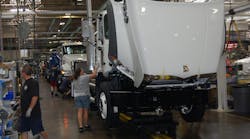North American orders for Class 8 trucks dropped to 16,800 units for May, according to data tracked by ACT Research; a 30% decline from April, the firm noted.
While Steve Tam, ACT’s vice president, noted in a statement that May’s Class 8 order volume is the lowest in the past seven months, it is still 18% higher year-over-year when compared to May 2016. On top of that, the May’s dip corresponds to a seasonally-expected decline in orders, he stressed.
“While the magnitude of the decline is greater than expected, the timing is spot on,” said Tam. “May is typically the time of the year when order intake drops below average.”
Don Ake, vice president of commercial vehicles for research firm FTR Transportation Intelligence, added that May’s order numbers “are not that worrisome” considering the steady volume of orders over the past seven months.
“It appears the typical summer order slump just showed up one month early,” he pointed out. “It does indicate the market is functioning normally and there is a steady, not robust, upward trend. The slowdown in order activity will give the OEMs a chance to get production lined up with demand.”
Total Class 8 orders for the past twelve months are running at about 211,000 units right now, Ake pointed out, and FTR still expects the Class 8 build and sales to continue to increase as the year progresses.“May orders were actually very close to our January forecast, so the market continues to move ahead as expected,” he noted. “Orders should continue at about this pace through the summer, which will be good enough to support stronger demand in third and fourth quarters.”
Michael Baudendistel, vice president of the transportation and logistics research group at Stifel Capital Markets added that he is “not shocked” to witness a “mid-year lull in order activity materialize” as recent order trends belied persistent weakness in core trucking markets.
“While we still believe there is more potential upside than downside to our 215,000 unit 2017 forecast, given a steeper-than-expected decline in May, we are leaving [that] outlook unchanged for now,” Baudendistel noted.
“We believe the Class 8 order weakness in May should be viewed as a step back from unsustainable levels,” he explained. “Overall, we continue to view North American [commercial] truck order trends over the past several months favorably, and believe conditions are setting up well for a strong 2019-2020, which should be years with significant replacement demand.”
North American orders for medium-duty trucks, by contrast, witnessed renewed strength in May, noted ACCT’s Tam, with orders for Class 5-7 units jumping to 21,200 units – up 13% from April and up 22% compared to May of 2016.
“Medium duty orders saw a resurgence, though not quite to the level they enjoyed in the December to March time period,” Tam added.
Yet Stifel’s Baudendistel remains “cautious” where medium-duty order trends are concerned.
He said Stifel is holding fast to its production forecast of 235,000 Class 5-7 units for 2017, up 1% from last year, as Class 5-7 orders are only up 2% from 2016 at this point.




